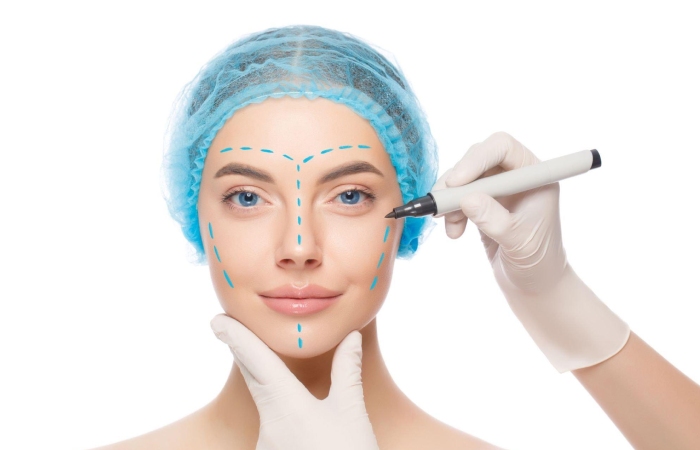Table of Contents
Introduction
Facial Cosmetic Surgery: It is satisfying and calm with our facial expressions so we can forget about it. It is what cosmetic surgery on the face is for. And it’s not the same for everyone because you have to consider age, cultural background. Personal preferences (that’s what you would like them to have), and the origin of each. Nevertheless, general ideas of beauty and established proportions between different facial structures serve as a guide to talking to the patient and agreeing on what is best for them.
With their knowledge of facial, cranial, and oral anatomy, oral and maxillofacial surgeons are highly skilled in performing cosmetic facial surgeries that include both functional and aesthetic aspects of the face, mouth, teeth, and jaws. For example, hidden incisions in the mouth, nose, or eyelids can transform the whole look.
Why is it Done?
Depending on what it is use for, facial plastic surgery interventions can divide into two large groups. Reconstructive or repair surgery and aesthetic or cosmetic surgery.
- Reconstructive/reparative surgery (including microsurgery ) focuses on concealing the effects of an accident or trauma, congenital malformations, and tumors of the face.
- On the other hand, aesthetic or cosmetic surgery generally treats healthy patients. It perform to modify parts of the face that are not satisfactory for the patient to improve their quality of life. However, there are cases with functional reasons, such as blepharoplasty or rhinoplasty.
What Does It Consist Of?

The intervention will depend on each case to treat. Generally, the process begins with one or more prior consultations with the surgeon. Who will assess the situation and explain to the patient the existing surgical treatment options, what the pre-and post-operative will be like, and the results that can expect.
It is essential that throughout the process, there is good communication between the surgeon and the patient and that the specialist makes sure that the patient understands the process that is going to start, the risks that it entails, and the realistic results.
Also Read: Skyrim: How to Cure Diseases in Skyrim?
Preparation for Facial Plastic Surgery
Before the operation, the specialist may require that tests such as clinical analyzes be carried out to check the patient’s health status and ensure that he can undergo the intervention.
The type of anesthesia, the duration of the intervention, and its risks will depend on each specific case.
Care After the Intervention
The postoperative and intervention care will depend on each type of surgery in particular. Although in most facial interventions, a period of rest is necessary after leaving the operating room.
It is also characteristic of facial plastic surgery that swelling occurs in the area. And the final results take weeks or even months to appear as the inflammation subsides.
Alternatives to this Treatment
Some techniques have been conventionally approaching through facial plastic surgery. Alternative strategies without surgery have remained developed in recent years. Which offers a result very similar or equal to that of surgery but without going through the operating room, such as facelift surgery.
Facial Surgery Treatments include
- Blepharoplasty: is a reshaping surgery of the upper or lower eyelid. It is indicate to improve the appearance of the gaze. In addition, it removes excess skin, fat, or bags under the eyes.
- Face and neck lift: with aging, the face and neck lose firmness, tone, and flaccidity appears in the contour and flaps in the neck. With this surgical procedure, the facial tissues are reposition, and the neck is lift. Restoring lost firmness and tone and giving a more youthful appearance.
- Otoplasty: is surgery to correct the ears, mainly those known as loop or puffed ears. Although it can also include lobe modification. In addition, auricular plastic surgery corrects the ear’s size and shape.
- Rhinoplasty: it is cosmetic nose surgery to modify nasal deformities. What is sought is to improve the look but achieve a harmonic result. Symmetrical with the rest of the face; for this, the chin and forehead are also taken into account.
- Facial lipofilling: this technique eliminates the sagging of the face by replenishing volume with the patient’s fat (extracted from the thighs, abdomen, and waist) in areas such as cheekbones, nasolabial folds, and jaw, thus restoring youth to the facial oval.
- Facial implants: they are use to improve the contour of the face (in the area of the chin, jaw, nose, cheeks, and paranasal grooves) and give it a more harmonious appearance. There are several types of implants made of different materials.
Conclusion
Facial cosmetic surgery is a three-dimensional procedure, and more highlighting it can place on facial form alterations given the fact that there are differences in expressions of the facial skeleton as well as the soft tissue proportions.
Also Read: Glamorous Black and Gold Nail Designs

